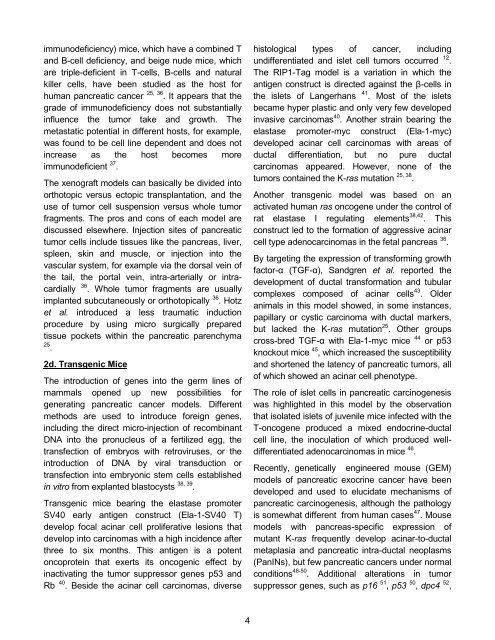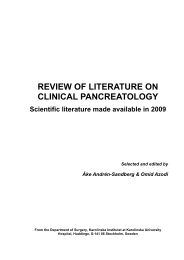Download PDF - The Pancreapedia
Download PDF - The Pancreapedia
Download PDF - The Pancreapedia
Create successful ePaper yourself
Turn your PDF publications into a flip-book with our unique Google optimized e-Paper software.
immunodeficiency) mice, which have a combined T<br />
and B-cell deficiency, and beige nude mice, which<br />
are triple-deficient in T-cells, B-cells and natural<br />
killer cells, have been studied as the host for<br />
human pancreatic cancer 25, 36 . It appears that the<br />
grade of immunodeficiency does not substantially<br />
influence the tumor take and growth. <strong>The</strong><br />
metastatic potential in different hosts, for example,<br />
was found to be cell line dependent and does not<br />
increase as the host becomes more<br />
immunodeficient 37 .<br />
<strong>The</strong> xenograft models can basically be divided into<br />
orthotopic versus ectopic transplantation, and the<br />
use of tumor cell suspension versus whole tumor<br />
fragments. <strong>The</strong> pros and cons of each model are<br />
discussed elsewhere. Injection sites of pancreatic<br />
tumor cells include tissues like the pancreas, liver,<br />
spleen, skin and muscle, or injection into the<br />
vascular system, for example via the dorsal vein of<br />
the tail, the portal vein, intra-arterially or intracardially<br />
36 . Whole tumor fragments are usually<br />
implanted subcutaneously or orthotopically 36 . Hotz<br />
et al. introduced a less traumatic induction<br />
procedure by using micro surgically prepared<br />
tissue pockets within the pancreatic parenchyma<br />
25 .<br />
2d. Transgenic Mice<br />
<strong>The</strong> introduction of genes into the germ lines of<br />
mammals opened up new possibilities for<br />
generating pancreatic cancer models. Different<br />
methods are used to introduce foreign genes,<br />
including the direct micro-injection of recombinant<br />
DNA into the pronucleus of a fertilized egg, the<br />
transfection of embryos with retroviruses, or the<br />
introduction of DNA by viral transduction or<br />
transfection into embryonic stem cells established<br />
in vitro from explanted blastocysts 38, 39 .<br />
Transgenic mice bearing the elastase promoter<br />
SV40 early antigen construct (Ela-1-SV40 T)<br />
develop focal acinar cell proliferative lesions that<br />
develop into carcinomas with a high incidence after<br />
three to six months. This antigen is a potent<br />
oncoprotein that exerts its oncogenic effect by<br />
inactivating the tumor suppressor genes p53 and<br />
Rb 40 . Beside the acinar cell carcinomas, diverse<br />
4<br />
histological types of cancer, including<br />
undifferentiated and islet cell tumors occurred 12 .<br />
<strong>The</strong> RIP1-Tag model is a variation in which the<br />
antigen construct is directed against the β-cells in<br />
the islets of Langerhans 41 . Most of the islets<br />
became hyper plastic and only very few developed<br />
invasive carcinomas 40 . Another strain bearing the<br />
elastase promoter-myc construct (Ela-1-myc)<br />
developed acinar cell carcinomas with areas of<br />
ductal differentiation, but no pure ductal<br />
carcinomas appeared. However, none of the<br />
tumors contained the K-ras mutation 25, 38 .<br />
Another transgenic model was based on an<br />
activated human ras oncogene under the control of<br />
rat elastase I regulating elements 38,42 . This<br />
construct led to the formation of aggressive acinar<br />
cell type adenocarcinomas in the fetal pancreas 38 .<br />
By targeting the expression of transforming growth<br />
factor-α (TGF-α), Sandgren et al. reported the<br />
development of ductal transformation and tubular<br />
complexes composed of acinar cells 43 . Older<br />
animals in this model showed, in some instances,<br />
papillary or cystic carcinoma with ductal markers,<br />
but lacked the K-ras mutation 25 . Other groups<br />
cross-bred TGF-α with Ela-1-myc mice 44 or p53<br />
knockout mice 45 , which increased the susceptibility<br />
and shortened the latency of pancreatic tumors, all<br />
of which showed an acinar cell phenotype.<br />
<strong>The</strong> role of islet cells in pancreatic carcinogenesis<br />
was highlighted in this model by the observation<br />
that isolated islets of juvenile mice infected with the<br />
T-oncogene produced a mixed endocrine-ductal<br />
cell line, the inoculation of which produced welldifferentiated<br />
adenocarcinomas in mice 46 .<br />
Recently, genetically engineered mouse (GEM)<br />
models of pancreatic exocrine cancer have been<br />
developed and used to elucidate mechanisms of<br />
pancreatic carcinogenesis, although the pathology<br />
is somewhat different from human cases 47 . Mouse<br />
models with pancreas-specific expression of<br />
mutant K-ras frequently develop acinar-to-ductal<br />
metaplasia and pancreatic intra-ductal neoplasms<br />
(PanINs), but few pancreatic cancers under normal<br />
conditions 48-50 . Additional alterations in tumor<br />
suppressor genes, such as p16 51 , p53 50 , dpc4 52 ,












